Let's have a chat about linking the EYLF outcomes and your programming cycle. Because from what I can see the often misunderstood ‘requirement' to link EYLF outcomes to every activity using numbers or complicated codes is causing educators an awful lot of unnecessary angst at the moment!
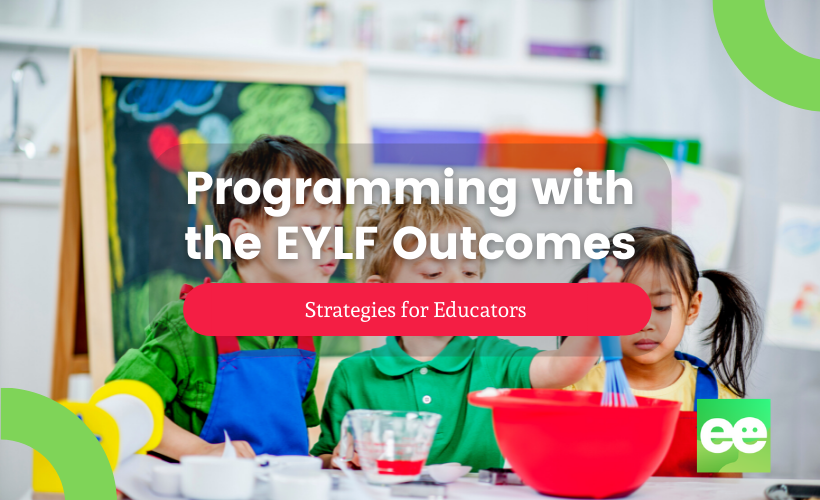
I have received some really heartfelt messages and emails lately from educators asking me to please help them to decipher the EYLF outcomes and advise how to link activities to those outcomes. Some educators have told me they are leaving the profession because they just feel to overwhelmed with this part of the planning cycle.
This really makes me sad because there are so many myths and unrealistic expectations floating about in the early childhood profession at the moment and unfortunately not everyone has the time, inclination or even the thought to challenge these myths or the expectations being placed upon them.
Knowledge and understanding can empower you in many ways, it can give you the confidence to ask questions, challenge directives that aren't explained well, engage in self and service reflection and most of all give you the confidence to ask for support or clarification so you can again feel in control.
I know that to find a path to this knowledge base and the clear answers that you seek can be difficult and frustrating. People who should be supporting and explaining often get caught up in explaining expectations with the use of lots of ‘important speak' and flowery jargon to help justify their position. I have found that often they do not fully understand why they are asking someone else to do something a specific way, they just ‘know' it must be done this way and therefore you must follow.
Now I'm not saying you should always challenge your boss, director, scheme, leader or management committee but you should endeavour to find the information you need for yourself first in a way that you can understand easily.
When you understand WHY something is being asked of you then you are able to ask informed questions and seek some clarification.
What I'm trying to say is don't give up, just find someone who explains things a little better, in a way you are able to understand and feel confident with. Then come back ready for a discussion with the powers that be about more support or information or even offer an alternative suggestion for a way you would prefer to meet the expectation required of you.
Now that I have that off my chest I'd love to try and be that person for you when it comes to understanding how to best use the EYLF learning outcomes.
Remember that these are only my thoughts and interpretations and stem from my research, reading and hands on practice on expectations surrounding the EYLF and the document itself. They might not be what your management team believes. But hey, not going to let that stop me, it's always good to have a healthy debate and reflect on best practice!
Enough waffling, let me try and break this down a little for you and answer some of the questions I have been receiving lately….
Take a deep breath…..here we go!
How do I plan using the Early Years Learning Framework Outcomes?
The NQS says in Element 1.1.2 that “Each child’s current knowledge, ideas, culture, abilities and interests are the foundation of the program” .
Element 1.2.1 states that “Each child’s learning and development is assessed as part of an ongoing cycle of planning, documenting and evaluation“
I believe this indicates that we draw on children's ideas and interests as well as their knowledge, culture and abilities and to be able to do this we must know children well.
How do we get to know the children in our care this well? We can do this many ways but one important way is through a form of observation and reflection/evaluation and then being able to use that knowledge to plan for future experiences.
The EYLF document talks about a cycle of planning, documenting, and evaluating. You can see what I have written about the planning cycle in this previous post – but really all you need to remember is that the observations and assessment you are recording must be meaningful, they must be specific and they must support you to support the child's learning journey and their steps forward.
If it doesn't then you have wasted your time and the child in your care hasn't benefited either. I tend to take a photo of a moment I know is important and then come back to it later to analyse. I also take photos that I know a parent will find important for general parent communication.
It is vital to include parents in your planning cycle too and this is why I firmly believe that when talking about outcomes and including them in your programming it should be in a way that everyone can understand.
The learning outcomes are an important part of the early years learning framework, not only because they help you as an educator to identify some key aspects of what you are aiming to achieve for each child but also because they support us to think about learning over the long term.
Do you reflect on the outcomes in relation to long term planning or just to fit an activity into a slot?
I like to try and use the outcomes to guide my planning over the long term. To help me look ahead and forward plan.
I don't do this by simply stating I have covered outcome 1 on Monday or outcome 2 by the end of the week as I feel this could be very limiting to an individual or groups potential. I work towards including them holistically by ensuring my program template covers all outcome areas without needing to constantly list outcome numbers or colour code.
If I have a few activities in each area I know that I am working toward ensuring that the children in my care are receiving access to play and learning opportunities and experiences that encompass all of the outcomes.
I might have an idea of the outcome I am focusing on with individual focus activities and intentional teaching activities but it really does evolve from there and I think about the outcomes usually only when analyzing and evaluating experiences.
I guess what I am trying to say is that ‘meeting outcomes' is not my sole focus when planning my program. I don't let that take over the importance of the observations and experiences I have seen and extended upon over the week or fortnight. I don't believe you should let it take you over either.
The EYLF outcomes are broad enough to capture the essence of what most educators are trying to achieve but not so general that they end up being meaningless. Interpreting them with your own insight and vision is the key.
I don't really see them as a limiting resource but as a broad guide to programming decisions – inviting us to watch carefully and listen closely to children rather than planning a set program based on something we, or others expect to see.
When you are constantly trying to ‘match' outcomes to experiences you can easily lose the genuineness of the children's experiences as you seek to ensure they are meeting the outcome you intended.
How do I interpret the EYLF Outcomes?
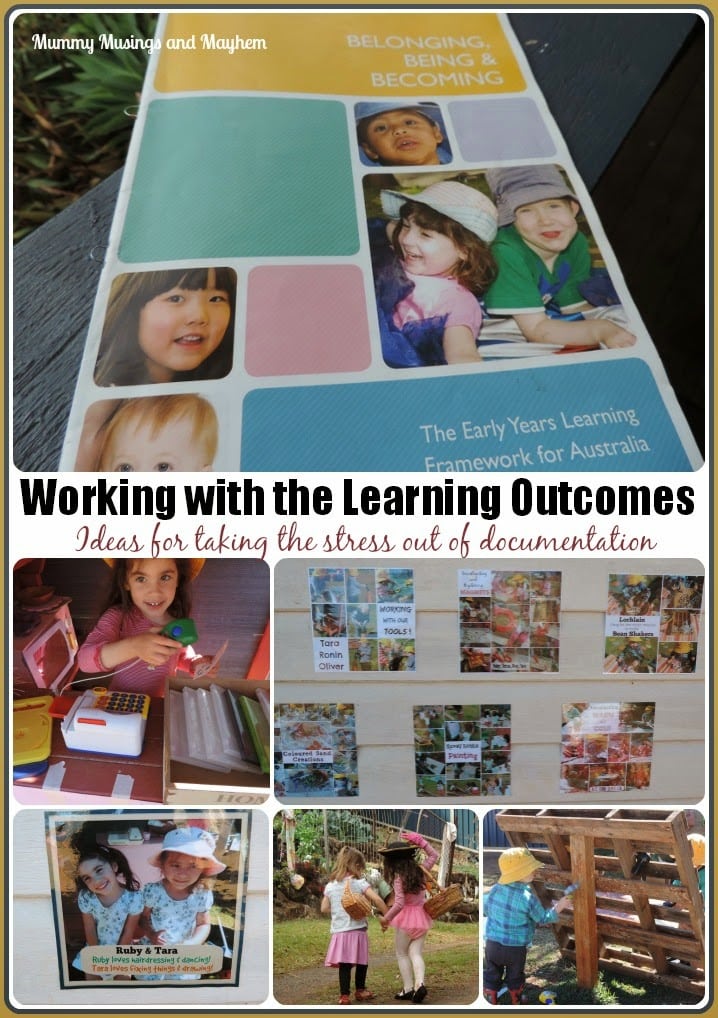
I'm sorry that I don't have a magic answer to this one for you as I know many find the wording and categories of the framework difficult to understand and interpret.
Really, the only thing that worked for me was reading the framework and focusing on the keywords and points. The Educators Guide to the framework is also very helpful and you can download it for free HERE . It is not enough to just read the principles and main headings of the outcomes. You need to read through the dot points underneath and think about how the activities you currently offer might fit into those areas.
If you find it difficult to understand the examples given then take a step back and think about the children you currently have in care in relation to a learning outcome, use your own words.
For example…How do you ensure that the children have a strong sense of identity? How might you see this? How can you support them and promote their learning in this area? Think about these questions in the context of your own service rather than what is written in a book.
The most common mistake I see is educators trying to slot one activity into just one outcome. Why do we need to be so rigid? Why put that pressure on yourself? Why not think holistically and consider that the activity might actually fall under a few outcomes and that is perfectly ok?
Also, consider that one activity might meet different outcomes for different children. It does not need to be an exact science. I often put one particular activity on my plan in a certain learning area but I know that it might also cover another 3 areas – no need to write it in every box though, just be aware that one experience can incorporate many different learning and developmental areas.
How do I know which activity goes with which EYLF outcome?
For example, a simple activity with scissors can fall under a number of the outcomes when you consider the children are cutting ‘everyday food ‘ pictures from recycled paper to explore healthy eating and sustainability. They are also practising colour recognition, eye-hand coordination, fine motor skills, problem-solving, and communicating.
I pretty much use my learning outcomes after the fact. How? I tend to use my observations and other documentation to explore the outcomes met. I incorporate the EYLF wording into this documentation rather than a specific number (eg. 1.1 etc)
I prefer to just observe something interesting from a child and then think about which outcomes it matches up with and record/assess that way.
In terms of my program I will record a few intentional teaching opportunities with a planned outcome in mind but everything else I just add after its happened. I might focus on one of those opportunities, all or none because the play evolved along a different path. And that is ok – I like to plan ahead with possibilities and opportunities listed but not everyone works in that way and that's ok too!
So how do I personally do that? Here's a brief example of a short observation using the wording of the EYLF instead of labeling the experience with an outcome number…
This observation clearly demonstrates Ruby has a growing understanding of sustainable practices as well as an increased understanding of the interdependence between the land, people and plants.
Did you connect this observation with Outcome 2 – Children are connected with and contribute to their world? I've basically combined an observation with a part analysis here for the purposes of showing you an example.
I would include the same sort of wording when planning my extension activity based on this observation. This is a little wordier than I would normally do but I wanted to give you a clear example of what I mean.
The order I completed this process was first to be in the moment with Ruby, discuss and problem solve with her, listen to her learning journey, I took some photos as I always have my camera close by for these moments. I remembered her words because I thought they were so very significant so they stuck with me.
I didn't turn away and lose focus because I was writing something down, I was actually joining in and experiencing.
Later at rest time when I loaded photos onto the computer, I was reminded of this special moment and saved a few photos relating to this moment in Ruby's observation folder in her electronic portfolio on my computer. Sometimes I also add some notes at this stage but not often.
When I began to write my ‘Our Day' daily reflection/communication sheet for the parents (and my own records) I included this moment briefly as a dot point with some of Ruby's own words included along with a picture.
This then acts as another record I have to use for next week's forward planning even if I haven't as yet completed the formal observation. I just include the date along with the planned activity relating to this day of the Our Day form onto next week's program activity plan under ‘children's interests' or ‘individual focus activity'. So it's like a shortcut really and another way that I use my Our Day forms to cover many documentation areas if I am short on time.
Later in the week I arranged the photos quickly into a collage and added the observation above while sitting with the framework beside me.
By using the language of the outcomes in this way I have gained a much deeper and clearer understanding of the EYLF and the terminology used. If I have time I will then add a short analysis to my forward planning form but often this gets done at a later time and then I will plan an extension activity from this analysis…again including the wording of the EYLF.
To me, this means a lot more than just putting the outcome number next to an observation. You still have to write an observation, you aren't making more work, by including the wording in your observation you are actually saving yourself time further along the planning cycle…and others will understand what you are recording.
Obviously, I have just tried to explain this as briefly as I could but it's hard to explain everything when writing. Please ask any questions you might have and I'll try to answer. Remember though that this is the system that works for me, it might not for you but I hope it helps in some way! Take what you find useful and modify it to your own needs. I explain the planning cycle and finding your own rhythm and system in THIS E-BOOK .
Do I need to link my planned activities to the learning outcomes?
I think this phrase from the EYLF Myths and Realities factsheet is important to note
“The emphasis in the EYLF is on planning for learning—not just planning activities. Some activities and resources may regularly be available to children, but as well, educators need to plan and organise particular experiences that support children to make progress towards each learning outcome. Educators may also plan other strategies, such as specific one-on-one interactions, to assist each child’s learning and development.”
Do I need to link my individual and group observations to the EYLF learning outcomes?
I cannot find any evidence in the NQS or EYLF that supports the notion that educators need to physically link their observations or other information they have collected about individual children to the Principles and Practices on their documentation.
1. The Question Step – Educators should analyse what they know about individual children in relation to the framework's learning outcomes from the information that you have worked towards collecting (your observations, learning stories ,portfolio info etc). Have you identified group or individual strengths, interests and goals?
2. The Plan Step – You must then be guided by the framework's learning outcomes, principles and practices to support further learning in those areas. It might be one or all of the areas. Have you clarified what you want to now extend or focus on for the group or individuals learning journey? Have you identified what role you as educator will take in this extension? Have you made a plan for how you will present and evaluate the learning activity?
3. The Act/Do Step – My personal favourite! Keeping your planning in mind, set up your environment for the activity, consider the framework areas you are focusing on or others that might now come to mind as you observe and document the learning taking place. Have fun with the children while implementing your plan!
3 The Reflect/Review Step – And finally use them again when evaluating or reflecting on the activity and the child's engagement and learning progress. How did it go? Did other learning opportunities arise? Did you notice a focus on a particular outcome or principle?
If you want to read more about how I personally approach this planning cycle you can read this post and this post from my educator series.
So yes we must always be guided by the framework's learning outcomes and principles when considering our individual and group planning but that does not mean we need to be rigid in always writing down the specific outcomes in our documentation and only focusing on those because they are there in front of us on a plan.
I think it is important to remember is that as educators we must always use a range of different ideas, principles and outcomes to understand what learning is taking place. If you are just focusing on linking it might not be enough. For example…2.1 written next to a planned activity or experience doesn't tell anyone much (least of all parents) but by planning, describing and analysing in your own words what the children in your care know, do and understand then you can do some clear assessments about where the children's learning falls under the 5 learning outcomes.
I fear many educators are now focusing too much on interpreting their observations with the use of a learning outcome number. It has become the ‘thing that must be done' and is causing an awful lot of stress for many while actually not being very helpful to anyone!
“The NQS suggests that assessors may need to sight ‘documentation demonstrating that the five learning outcomes are evident in documentation of children’s learning’. (Element 1.1.1) The information gathered about the child should be analysed and linked to the Learning Outcomes.However, when analysing a child’s learning, educators assess progress over a period of time, rather than ‘leaping to a judgement’ linked to an Outcome.Young children will be ‘working towards’ the learning outcomes and documentation should make this progress visible to the educator and others.”
Documentation demonstrating that the 5 learning outcomes are evident in your planning and the children's journey does not mean limiting yourself or a child to an outcome number. Your documentation just needs to show their progress towards the learning outcomes over time. There are many ways to do this rather than just focusing on what outcome was met for one specific activity last Monday. You need to shift your thinking and focus on the child's overall journey. If you let go of the expectation that you need to first link everything correctly to the framework you might be able to get back to just being in the moment with the child as you work together and begin to collect your ‘evidence' holistically.
Using your own words will help you understand the EYLF more deeply and also enable you to see the outcomes being expressed differently between children. Try to write in a way that will enable your ‘word pictures' to clearly identify all outcomes with not a number in sight!.
Consider also the other ways you can demonstrate a commitment to the EYLF outcomes….Your policies should reflect them, your behaviour and interactions should reflect them and they will be evident in your professional reflections. Just because you can show someone an observation that identifies an example of a particular principle, practice or outcome doesn't convince me that they are applied consistently.
Why is it important for others to understand ‘my system'?
You might be getting the idea that I really dislike seeing codes on programs, especially those detailed ones that families do not understand. My other concern with them is that the time spent looking for the code can be so much better spent on the floor with the children. I much prefer to see the language of the outcome being used. It gives so much more depth to planning and reflection.
Coded observations and reporting often only means something to the person who invented it. I have worked in services who follow a fancy system but can't explain it – so in the end it's of no value really.
If you want to engage everyone in this – staff, parents, coordinators, leaders, relief educators, then you need to try and make your systems at least a little transparent. It doesn't take too many extra words to provide an observational example and then add this to demonstrates an outcome ” is met because …..”
Not only will you, your centre colleagues, relief worker or visiting coordinator understand that, but so will the parent, who might then see other examples of their child demonstrating learning at home.
I think that if we want parents and the broader community to have a greater understanding of the value of a quality early childhood experience then we need to be more open, more articulate about our practice and far more transparent in what we know and how we show we know about children and their learning.
The outcomes provide an excellent way of demonstrating that if used effectively. If you can learn to write your documentation with an understanding that it has to “speak” to lots of audiences then I think you will have a better sense of how to write and share your documentation.
I know some educators will say that writing in this way will cause more work than just coding but if you look at it in the context of your overall planning picture I think you will be surprised at how much time it can save you…and others.
Want more ideas & inspiration and to connect with other passionate professionals who love working with children?
You need to join my exclusive
Empowered Educators Facebook Community
It's FREE!
A Little About Me
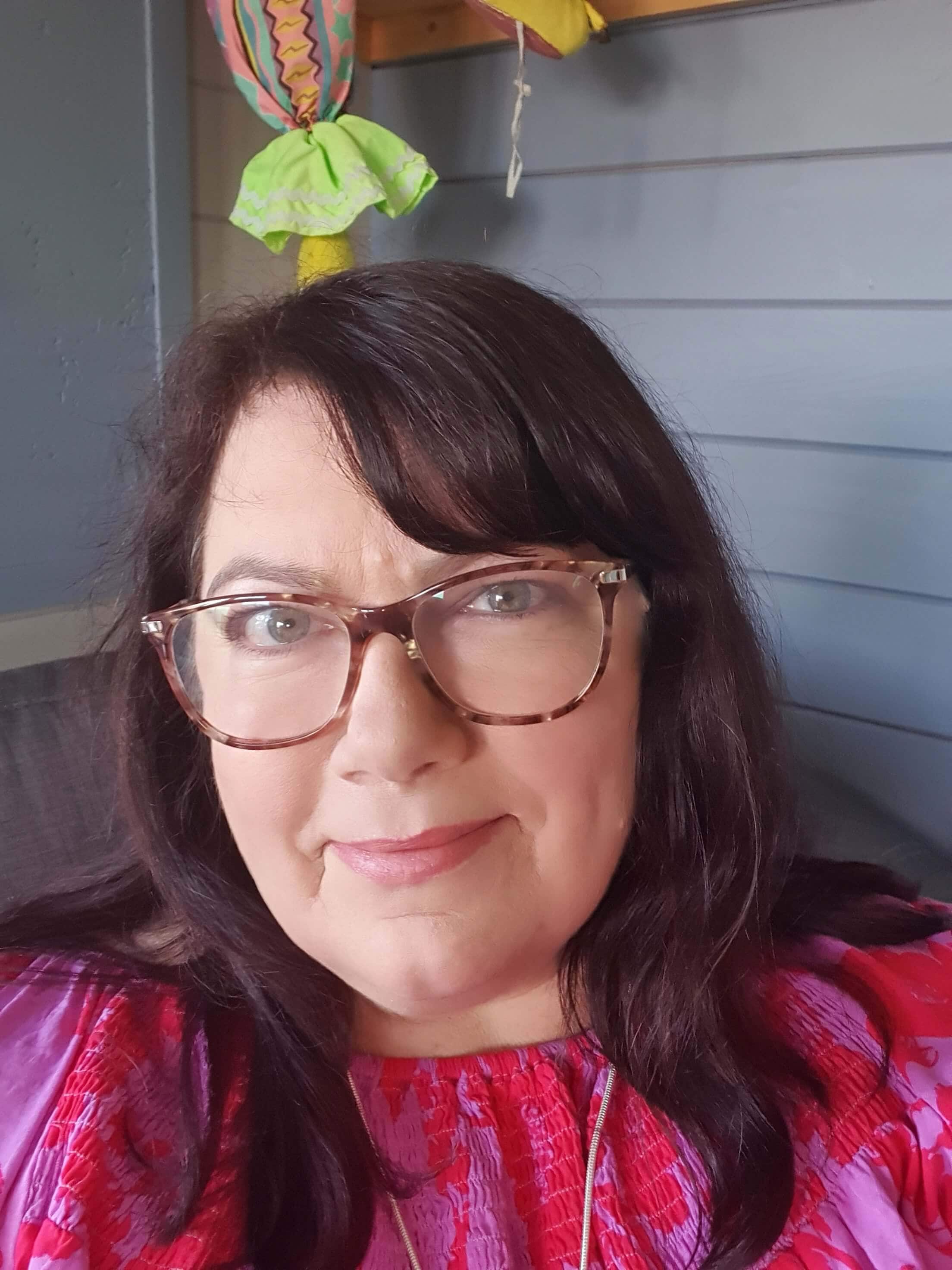
Jodie Clarke is an early childhood professional supporting educators who want and need to stay passionate about the work they do! She has 30 years hands-on experience in the early childhood and human services sectors across many different roles.
Jodie is mum to 3 in Australia and has already helped thousands of educators with their work through her popular blog posts, activity ideas, online training and e-books.
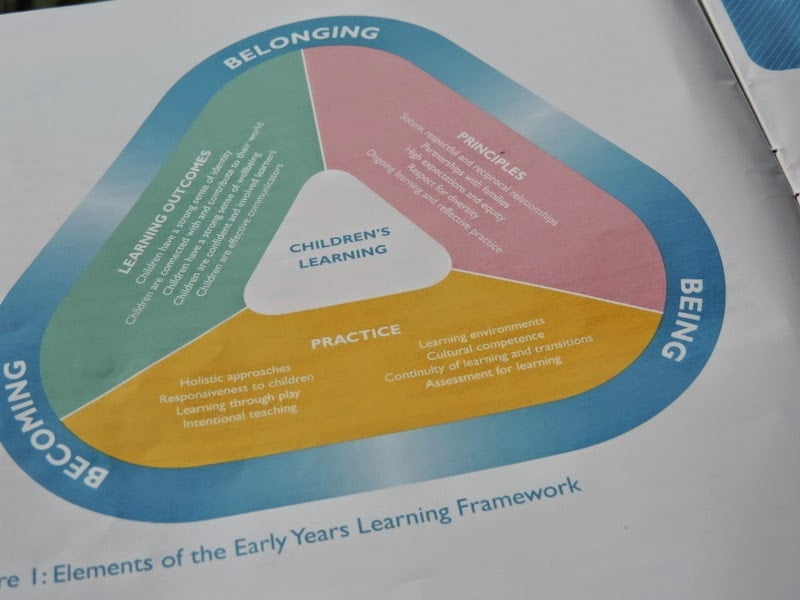
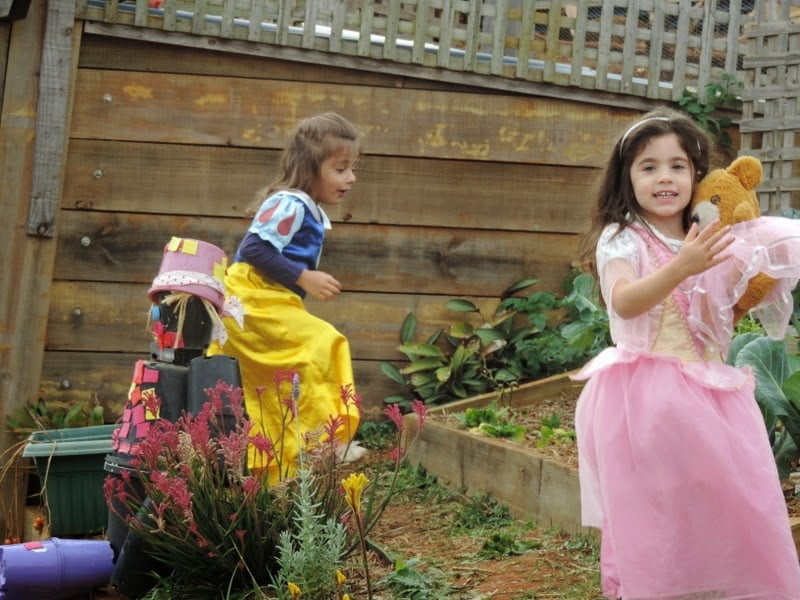
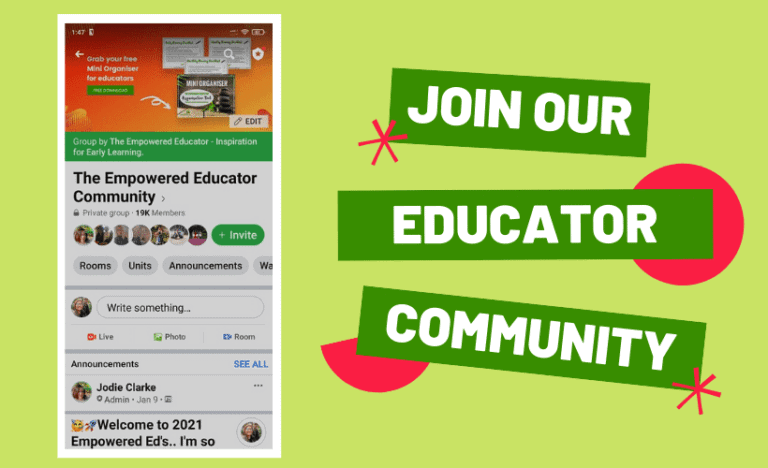
I am from indiana, can we buy this book, I would love to read it. Thanks lisa
Hi Lisa, it’s an ebook so you download it to your computer after purchase. Just visit my shop page and it’s all pretty easy, thanks for your interest and a big hello to Indiana!
Thoroughly enjoyed reading this. Thank you. Always felt that putting in a number was of no value. I like the way you have explained how to incorporate the wording relating to the eylf learning outcomes.
Thanks Kelly, am so glad you found the article useful. I’m not sure why everyone feels this need to link numbers to everything really..I personally could think of nothing worse, hopefully programming might become a little quicker for you now 🙂 Thanks so much for your feedback!
Hi love site. Was hoping you might also include MTOP framework also as I am in the OSHC service.
Kind regards,
Sarah
Working towards it Sarah – have had a few requests now 🙂
I’m really enjoying reading your postings. I’m in Minnesota, US and we are trained to focus more on curriculum areas ( right now the Science, Technology, Engineering and Math drive is the big thing.) I find your Outcomes to be more in tune with the growing child. I like your phrase, “learning journey”. Thanks for all the time and work you put into this blog! I love your use of photos. My goal for this week is to use my camera more. Thanks!
Thanks for sharing with us Barbara! When I first trained many years ago we also focused mainly on specific areas such as cognitive, social/emotional, physical. language etc. The early Years learning framework outcomes I feel is a much better approach although many do not like it here and find it confusing! I think as you mentioned it allows us to be more in tune and work with a child on their journey rather than just leading them constantly.
So glad I inspired you to get that camera out – it really is such a valuable tool to busy educators and teachers and can capture so many important moments…and saves so much time I believe if we think carefully about how we might use visual displays of learning. So pleased to have you here, thanks for your kind feedback 🙂
Hi Jode
I’ve read so much of your advice about planning and documenting the learning cycle and use bits and pieces as I go which have been so helpful so thank you,
I know you’ve said that we don’t need to use numbers in our observations and nowhere does it say how many we must do either; but I was wondering if we ‘have to’ do Observations separately to our programmes or can we do it all in one place? In thinking of ways to cut down documentation, I thought I could; eg: put photos of an observation in the programme and a paragraph that analyses it; forward plan (on my Individual Learning Records), then add a focus activity/extension to the next programme and pics of it, plus a few words about how it went (in ‘outcome speak’), and the date it was completed?
Separately for each child, I would also have (modifying your Individual Analysis and Forward Planning Record headings to:
Observation Date
Programme Featuring Ob
Forward Planning
Programme Featuring Extension Act
Extension Evaluation & Date)
This way the Cycle of Planning would only take 2 docs, and all the learning that’s taken place for each child could be seen on their ‘Individual Record’ page as an overview with references to the programmes for ‘evidence’ of them?
AL